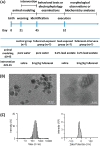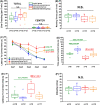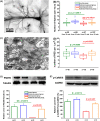Long-term maintenance of synaptic plasticity by Fullerenol Ameliorates lead-induced-impaired learning and memory in vivo
- PMID: 35909130
- PMCID: PMC9341061
- DOI: 10.1186/s12951-022-01550-2
Long-term maintenance of synaptic plasticity by Fullerenol Ameliorates lead-induced-impaired learning and memory in vivo
Abstract
Fullerenol, a functional and water-soluble fullerene derivative, plays an important role in antioxidant, antitumor and antivirus, implying its enormous potential in biomedical applications. However, the in vivo performance of fullerenol remains largely unclear. We aimed to investigate the effect of fullerenol (i.p., 5 mg/kg) on the impaired hippocampus in a rat model of lead exposure. Matrix-assisted laser desorption/ionization time-of-flight mass spectrometry (MALDI-TOF-MS) is a kind of newly developed soft-ionization mass spectrometry technology. In the present study, an innovative strategy for biological distribution analysis using MALDI-TOF-MS confirmed that fullerenol could across the blood-brain barrier and accumulate in the brain. Results from behavioral tests showed that a low dose of fullerenol could improve the impaired learning and memory induced by lead. Furthermore, electrophysiology examinations indicated that this potential repair effect of fullerenol was mainly due to the long-term changes in hippocampal synaptic plasticity, with enhancement lasting for more than 2-3 h. In addition, morphological observations and biochemistry analyses manifested that the long-term change in synaptic efficacy was accompanied by some structural alteration in synaptic connection. Our study demonstrates the therapeutic feature of fullerenol will be beneficial to the discovery and development as a new drug and lays a solid foundation for further biomedical applications of nanomedicines.
Keywords: Fullerenol; In vivo; Lead-induced impairment; Learning and memory; Synaptic plasticity.
© 2022. The Author(s).
Conflict of interest statement
The authors declare that they have no competing interests.
Figures







Similar articles
-
Suppression of synaptic plasticity by fullerenol in rat hippocampus in vitro.Int J Nanomedicine. 2016 Sep 28;11:4947-4955. doi: 10.2147/IJN.S104856. eCollection 2016. Int J Nanomedicine. 2016. PMID: 27729790 Free PMC article.
-
Fullerenol as a water-soluble MALDI-MS matrix for rapid analysis of small molecules and efficient quantification of saccharin sodium in foods.J Chromatogr B Analyt Technol Biomed Life Sci. 2021 Jul 15;1178:122819. doi: 10.1016/j.jchromb.2021.122819. Epub 2021 Jun 4. J Chromatogr B Analyt Technol Biomed Life Sci. 2021. PMID: 34130205
-
Visualization of fullerenol nanoparticles distribution in Daphnia magna using Laser Ablation-isotope Ratio Mass (LA-IRMS) and Matrix-assisted Laser Desorption/Ionization Imaging Mass Spectrometry (MALDI-IMS).Ecotoxicol Environ Saf. 2022 Mar 1;232:113226. doi: 10.1016/j.ecoenv.2022.113226. Epub 2022 Jan 29. Ecotoxicol Environ Saf. 2022. PMID: 35093811
-
Current Status of Matrix-Assisted Laser Desorption/Ionization-Time-of-Flight Mass Spectrometry (MALDI-TOF MS) in Clinical Diagnostic Microbiology.Molecules. 2020 Oct 17;25(20):4775. doi: 10.3390/molecules25204775. Molecules. 2020. PMID: 33080897 Free PMC article. Review.
-
Analysis of protein glycation products by matrix-assisted laser desorption ionization time-of-flight mass spectrometry.Curr Med Chem. 2004 Aug;11(16):2185-93. doi: 10.2174/0929867043364649. Curr Med Chem. 2004. PMID: 15279557 Review.
Cited by
-
Fullerenols Ameliorate Social Deficiency and Rescue Cognitive Dysfunction of BTBR T+Itpr3tf/J Autistic-Like Mice.Int J Nanomedicine. 2024 Jun 17;19:6035-6055. doi: 10.2147/IJN.S459511. eCollection 2024. Int J Nanomedicine. 2024. PMID: 38911505 Free PMC article.
-
Fullerenol inhibits tendinopathy by alleviating inflammation.Front Bioeng Biotechnol. 2023 Mar 30;11:1171360. doi: 10.3389/fbioe.2023.1171360. eCollection 2023. Front Bioeng Biotechnol. 2023. PMID: 37064249 Free PMC article.
References
MeSH terms
Substances
Grants and funding
- 81601158/the National Natural Science Foundation of China
- 82171218/the National Natural Science Foundation of China
- 81870723/the National Natural Science Foundation of China
- KJ2021A0821/Natural Science Research Project of Anhui Educational Committee
- WK202111/Young and Middle-aged Scientific Research Fund Project of Wannan Medical College
LinkOut - more resources
Full Text Sources

